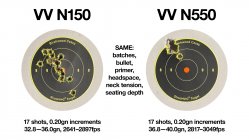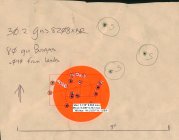So... some unexpected results from an initial load development session recently. Both targets were shot on the same day, following a few fouling shots.
I shot 17 different charge weights of N150, and then 17 of N550. Normally I don't go to the bother of shooting paper, as I'm shooting over a chronograph and I'm primarily interested in pressure signs.
In the past, when I have shot at paper, I would expect to see the POI wandering around in a similar fashion to what you see in the N150 target – although perhaps not quite as dramatically.
I've never seen a 17 shot string – which spans 3.20gn of powder, and 232fps ES – shoot as tight as the N550 target. Given that I had locked down every other variable, and specifically seating depth, I wasn't expecting the N550 target to look anything like it did.
Please note that on the N150 target, the lowest shot at 5 o'clock doesn't correspond to the lowest MV, and similarly, the highest shot at 11 o'clock doesn't correspond to the highest MV. Furthermore, where the N150 has common MVs to the N550 (2819–2897fps range) those POIs aren't occurring exclusively in the 11 o'clock area – they are wandering all over the place.
Working with an 8x scope with a relatively large floating centre dot, I actually thought I had only put 2/3 shots into the N550 target as I was performing the test. I got quite a pleasant surprise when I realised how the N550 had performed.
These results seem to cast some doubt on the common assertion that group size is almost exclusively determined by seating depth.
I can't understand why two identical projectiles exiting the barrel with near identical MVs – one propelled by N150 and one by N550 – would have such wildly differing POIs?
Clearly powder choice has a larger bearing on group size, than the "powder charge for MV and seating depth for group size" mantra would have you believe.
Have you guys ever experienced anything like this?
I shot 17 different charge weights of N150, and then 17 of N550. Normally I don't go to the bother of shooting paper, as I'm shooting over a chronograph and I'm primarily interested in pressure signs.
In the past, when I have shot at paper, I would expect to see the POI wandering around in a similar fashion to what you see in the N150 target – although perhaps not quite as dramatically.
I've never seen a 17 shot string – which spans 3.20gn of powder, and 232fps ES – shoot as tight as the N550 target. Given that I had locked down every other variable, and specifically seating depth, I wasn't expecting the N550 target to look anything like it did.
Please note that on the N150 target, the lowest shot at 5 o'clock doesn't correspond to the lowest MV, and similarly, the highest shot at 11 o'clock doesn't correspond to the highest MV. Furthermore, where the N150 has common MVs to the N550 (2819–2897fps range) those POIs aren't occurring exclusively in the 11 o'clock area – they are wandering all over the place.
Working with an 8x scope with a relatively large floating centre dot, I actually thought I had only put 2/3 shots into the N550 target as I was performing the test. I got quite a pleasant surprise when I realised how the N550 had performed.
These results seem to cast some doubt on the common assertion that group size is almost exclusively determined by seating depth.
I can't understand why two identical projectiles exiting the barrel with near identical MVs – one propelled by N150 and one by N550 – would have such wildly differing POIs?
Clearly powder choice has a larger bearing on group size, than the "powder charge for MV and seating depth for group size" mantra would have you believe.
Have you guys ever experienced anything like this?












